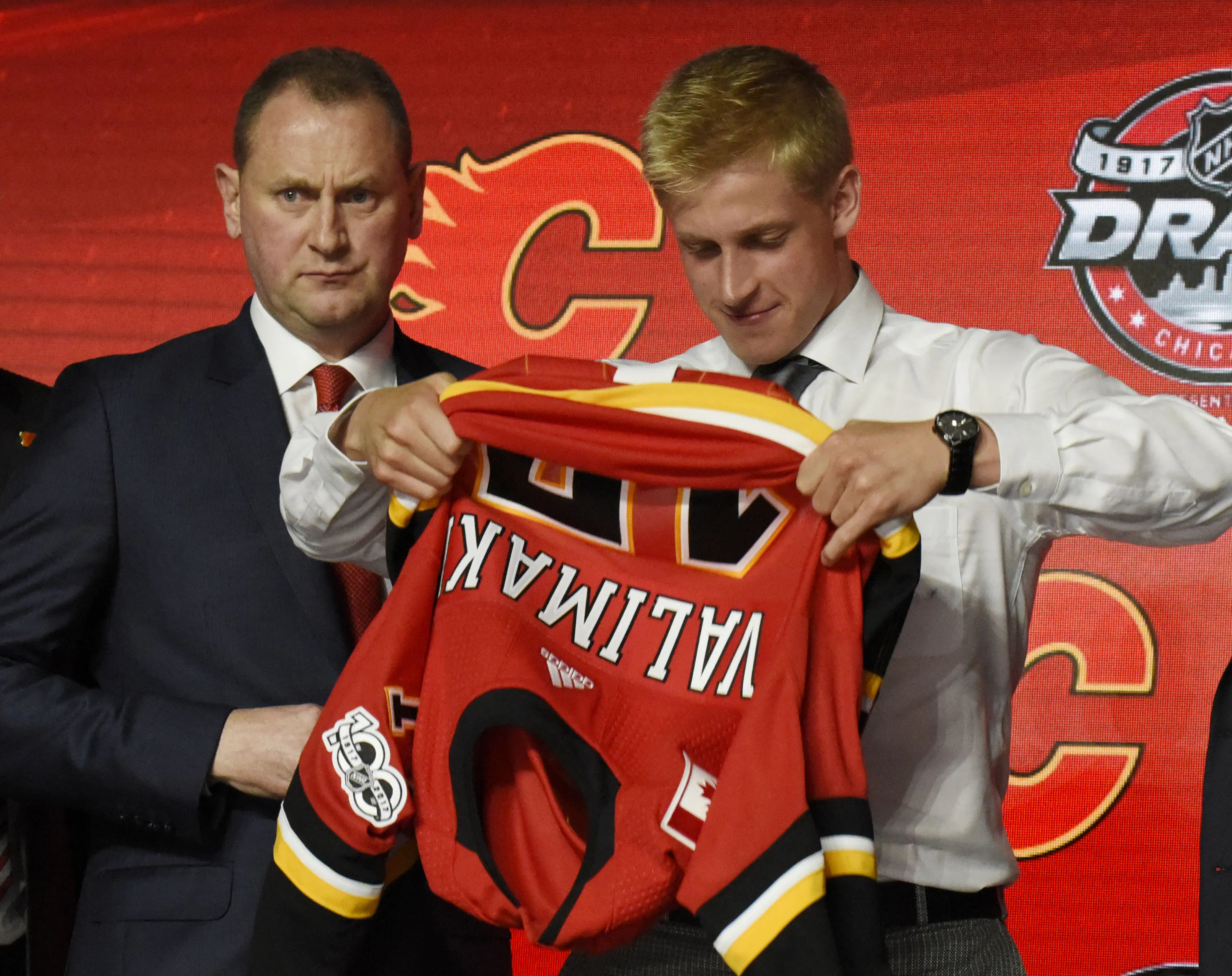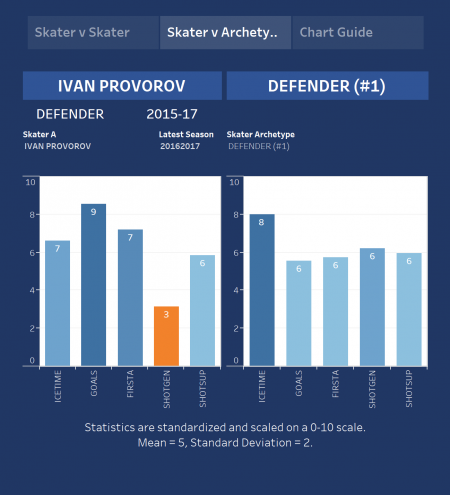A closer look at Juuso Valimaki

By Kent Wilson
6 years agoTypically when picking in the middle of the first round, an NHL team can expect to get a skilled but flawed player. Many “boom or bust” prospects slide out of the top 10 because of some perceived personality problem or because they lack at least one key ingredient in their game: size, speed, offense, hockey sense, etc.
That doesn’t seem to be the case for the Calgary Flames with Juuso Valimaki. The 18-year-old Finnish defender ticks all the boxes from a qualitative perspective: he has NHL size (6’2″, 210 pounds), and according to most scouting reports, he can skate, he has high hockey IQ, and a solid, well-rounded game.
From a quantitative perspective, Valimaki is even more impressive. In fact, not only does he appear to be one of the best bets of the 2017 draft, but his results stand out as some of the best amongst first round defensemen of the past five years.
We’ll start by comparing Valimaki to his peers. This year he was by far the most dominant WHL defender in terms of offense. From Prospect-stats.com:

Valimaki led all WHL defensemen 18 years old or under in goals, points, primary points, and points per game. In fact, even if we expand the field to include all WHL blueliners, Valimaki still places top five in most of these categories.
Offense seems like a secondary factor when it comes to evaluating defensemen, but it’s one of the most predictive variables when we’re talking about projecting a prospect to make the NHL. Years ago, Rhys Jessop (formerly of Canucks Army and developer of the original SEAL system we have used for the top 100 prospect profiles this year) found that offense is essential in evaluating prospective blueliners:

Which is why, based on his output this season, Valimaki has a better than 64% chance of making the NHL when we look at his historical comparisons:
To add further context, I went through and compared Valimaki to some of the noteworthy defensemen who were taken in the first round going back to 2012. Here’s the list, sorted by NHLe (NHL equivalence):
| Player | Draft position | league | PTS | GP | PPG | NHLe |
|---|---|---|---|---|---|---|
| Juuso Valimaki | 16 | WHL | 61 | 60 | 1.02 | 24.1 |
| Ivan Provorov | 7 | WHL | 61 | 60 | 1.02 | 24.1 |
| Cody Ceci | 15 | OHL | 60 | 64 | 0.94 | 23.5 |
| Aaron Ekblad | 1 | OHL | 53 | 58 | 0.91 | 22.9 |
| Seth Jones | 4 | WHL | 56 | 61 | 0.92 | 21.8 |
| Julius Honka | 14 | WHL | 56 | 62 | 0.90 | 21.5 |
| Mikhail Sergachev | 9 | OHL | 57 | 67 | 0.85 | 21.3 |
| Matt Dumba | 7 | WHL | 57 | 69 | 0.83 | 19.6 |
| Derrick Pouliot | 8 | WHL | 59 | 72 | 0.82 | 19.5 |
| Noah Hanifin | 5 | H-EAST | 23 | 37 | 0.62 | 19.2 |
| Callan Foote | 14 | WHL | 57 | 71 | 0.80 | 19.1 |
| Zach Werenski | 8 | Big-10 | 25 | 35 | 0.71 | 18.5 |
| Olli Juolevi | 5 | OHL | 42 | 57 | 0.74 | 18.5 |
| Ryan Pulock | 15 | WHL | 45 | 61 | 0.74 | 17.5 |
| Haydn Fleury | 7 | WHL | 46 | 70 | 0.66 | 15.6 |
| Jakub Zboril | 13 | QMJHL | 33 | 44 | 0.75 | 15.1 |
| Darnell Nurse | 7 | OHL | 41 | 68 | 0.60 | 15.1 |
| Olli Maatta | 22 | OHL | 32 | 58 | 0.55 | 13.8 |
As you can see, Valimaki isn’t just sharing some rarified air, he’s right at the top of the list. Not even Aaron Ekblad posted a PPG or NHLe as high as Valimaki did this season.
I have also highlighted guys on the list who are currently playing in the NHL (just under 50%). Already you can see that many of the guys here are every day (if not impact) NHL players, even though we’re talking about some very recent drafts.
Ivan Provorov is an interesting comparable given how close his results match Valimaki’s: same league, same amount of points, same number of games, same NHLe. Provorov was picked seventh overall in 2015 and played just one more season in the WHL before making the leap directly to the show this year.
What’s interesting is Provorov had an excellent rookie season despite his young age. It’s the kind of debut that would normally garner Calder consideration if the league had not been jammed with so many high-end quality kids.
Here’s how his underlying numbers look so far:

Excellent shot suppression and offense while shot generation needs improvement. Still, this is a way above average look for a rookie.
As for counting stats, Provorov scored six goals and 30 points in 82 games. What’s most impressive, though, is he lead the Flyers’ blueline in terms of even strength and overall ice time per game. That’s an amazing feat for a kid who turned 20 during the season.
Conclusion
Unlike most guys you typically get outside of the top 10, there are almost no statistical or intangible red flags when it comes Valimaki. His scouting reports are glowing and his numbers are some of the best I can find.
The worst things you can say about the player is he is old for this draft class (almost 19) and his offensive game isn’t “flashy”. The latter knock seems to be what suppressed his draft rankings somewhat, with scouts wondering if his offense would translate at the next level. That said, even without flash to his game style, Valimaki put up some of the best totals we’ve seen from a defenseman in years.
Obviously, the caveat here is we are blind to certain key factors like usage, linemates, quality of competition, etc. Also, glancing at the list of players I shared above, we can see that scoring doesn’t perfectly project a player’s quality in the NHL (Cody Ceci scored more than Ekblad, but he’s a fairly middling NHLer for example).
Nevertheless, it’s hard not to be optimistic about Valimaki’s future in the Flames organization. Looking at his package of skills and results, one wonders how Valimaki wasn’t tabbed as a top 10, if not top five, pick in this year’s draft.
As a result, he instantly jumps to the top of Calgary’s prospect ranks and may be a guy who challenges for a spot on the big club sooner rather than later.
Recent articles from Kent Wilson





